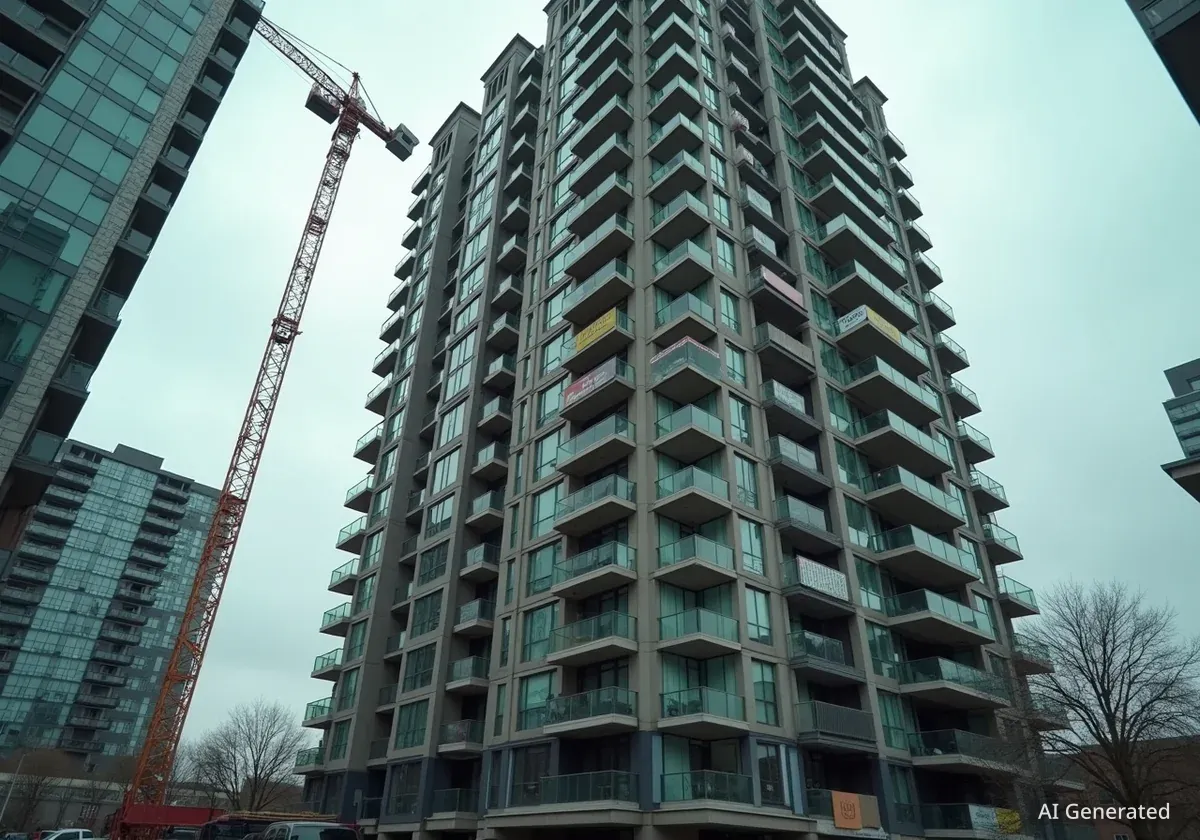Metro Vancouver is facing a significant increase in unsold new condominiums. Data from the Canada Mortgage and Housing Corporation (CMHC) shows approximately 2,500 newly constructed condos are currently vacant and available for sale across the region. This figure represents a doubling of inventory compared to the previous year, signaling a notable shift in the local real estate market.
Key Takeaways
- Around 2,500 new condos are unsold in Metro Vancouver, double last year's number.
- High construction costs and government policies are blamed for unaffordable prices.
- Some developers are returning deposits due to missed pre-sale targets.
- The slowdown, evident since March 2022, is impacting the labor market.
- Buyers seek larger units for similar prices, contrasting with smaller new builds.
Rising Costs Drive Unaffordability
Real estate executives point to escalating construction costs as a primary factor behind the growing number of unsold units. These costs make new condos unaffordable for a large segment of the local population.
Anne McMullin, President and CEO of the Urban Development Institute, stated that building a new unit now exceeds the budget of 80 percent of residents in Metro Vancouver. This cost barrier directly contributes to the inventory surplus.
"Costs have escalated so much in the last 10 years that to build a unit is out of the price range of 80 percent of the public in the Metro Vancouver area," McMullin said.
Policy Impact on Development
McMullin also attributes the current market challenges to government policies at all three levels: municipal, provincial, and federal. She argues these policies have increased development expenses.
Developers are unwilling to sell properties at a loss. For years, the market absorbed rising expenses, including labor and material costs, based on the expectation of continued price increases. This trend has now changed.
Fact Check
- 2,500+ new condos unsold in Metro Vancouver.
- This number is double the inventory from last year.
- 80% of Metro Vancouver residents cannot afford new condo construction costs.
Developer Challenges and Market Slowdown
The current market conditions are creating significant difficulties for developers. Some are now unable to meet pre-sale targets, which are crucial for securing bank financing for new projects.
This situation forces developers to return deposits to prospective buyers. In more severe cases, some companies have entered receivership, a process where a receiver is appointed to manage the company's assets.
McMullin warned of a "potential storm coming" and reported that some companies have already begun laying off staff. She hopes local cities will review policies related to non-market rental housing, energy step codes, and public art requirements.
Historical Context of Market Shifts
Greg Zayadi, President of Vancouver-based development company Rennie, confirmed the market slowdown began in March 2022. He noted that the past year has seen the situation become "very real."
The real estate industry experienced a strong 20-year period. However, the recent decline in new condo sales is expected to have broad effects, particularly on the labor market.
Market Context
The last time Metro Vancouver saw such high levels of developer-owned unsold inventory was 24 years ago. This indicates the current situation is an unusual and significant downturn for the region's real estate sector.
Buyer Expectations Versus New Inventory
Zayadi highlighted a disconnect between what new condo buyers expect and what is being offered. Buyers spending $800,000 are generally not looking for small units measuring 450 to 500 square feet.
Instead, many buyers now seek larger condos, ranging from 800 to 1,500 square feet, for prices between $800,000 and $1.2 million. This preference for more space at a certain price point is not always met by current new construction.
He suggested that the industry and province need to deliver inventory at a cost of $700 to $900 per square foot. This is $200 to $300 above the current market price for many units.
Geographic Concentration of Unsold Units
The problem of unsold condos is particularly concentrated in specific areas of Metro Vancouver. These include Burnaby, Coquitlam, and parts of Surrey. These communities have seen significant new development, contributing to the current surplus.
Challenges with New Condo Features
Real estate agent Oleg Galyuk of Royal Pacific Realty observed that older condos tend to sell better than pre-sale condos. He noted that "the new inventory tends to sit on the market."
Several factors contribute to this lack of buyer interest in new units. Galyuk mentioned that the layouts of some new homes are a concern. Additionally, a lack of adequate parking spaces makes these new units harder to sell and rent.
- Older condos often sell faster than new pre-sale units.
- New home layouts can be a deterrent for buyers.
- Limited parking spaces make new units less attractive.
To attract buyers, developers are offering various incentives for built units. These include throwing in parking stalls and storage lockers. Some developers are also providing cash-back on completion of the purchase.
Galyuk believes some developers have focused too heavily on the "investor basket." He noted that many new condos coming online are units "people don't really want to live in," suggesting a mismatch between supply and genuine buyer demand.





